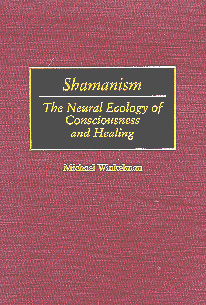

SHAMANISM:
The Neural Ecology of Consciousness and Healing
Book Details
By Michael Winkelman. Published by Bergin & Garvey. Westport, Conn. 2000. 336 pages. Includes bibliographical references and index. LC 99-040499. ISBN 0-89789-704-8. Clothbound, $65.00.
Click here to view the Table of Contents.
Quotes/Reviews
"This brilliant attempt to link shamanism with humanity's psychophysiological potentials helps explain why the contemporary world still hungers for transcendent experiences." --Choice
"Just as the ancient healing tradition was about to succumb to the denunciation
and scorn of rational thought, says Winkelman (ethnography, ASU) it experienced a
resurgence instead and is now practiced regularly in a wide range of religious systems
ranging from Pentecostal to Buddhist. He examines the psychobiological and psychocognitive
foundations of shamanism and related universal traditions concerned with the therapeutic
alteration of consciousness." --Book News
Abstract
Cross-cultural and neuropsychological perspectives on shamanism reveal that it produces an adaptive integrative mode of consciousness. Shamanic altered states of consciousness (ASC) are related to brain organization and processes, showing shamanism's concern with socioemotional and self functions of the paleomammalian brain and cognitive capacities based in presentational symbolism, metaphor, analogy, and mimesis. Integration of cross-cultural and neurological perspectives illustrates homologies which reveal the psychological basis of shamanism and soul journeys, guardian spirits, death and rebirth, and other universal forms of shamanic cognition.
Shamanic contributions to sociocultural and cognitive evolution are examined.
The integrative mode of consciousness produced by shamanic ASC is related to general brain
functions. Specific psychophysiological functions of ASC and their variations cross-culturally
are illustrated. Shamanic soul journey, possession, and meditative forms of consciousness
are examined from phenomenological, neurological, and epistemological perspectives which
reveal them to be innate forms of cognition and practices for manipulating perception,
attention, cognition, emotion, self, and identity. Shamanistic healing involves physically
and culturally mediated forms of adaptation to stress which are reinforced by procedures
eliciting opioid release. Therapeutic effectiveness of shamanistic practices are illustrated
by clinical research. Shamanistic healing includes procedures for altering physiological,
psychological, and emotional responses. Contemporary spontaneous religious experiences and
illness characterized as "spiritual emergencies" have shamanic roots and illustrate the
continued relevance of shamanic paradigms.
To Order a Copy
Contact Greenwood Press at 1-800-225-5800 or order online at http://www.greenwood.com.
Contact Amazon.com.
Contact Barnes & Noble at
http://www.bn.com.
http://www.public.asu.edu/~atmxw
Page last updated: September 17, 2003
Webmaster: slbobar@asu.edu
ASU Disclaimer